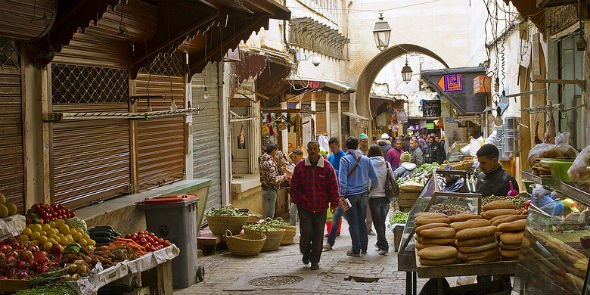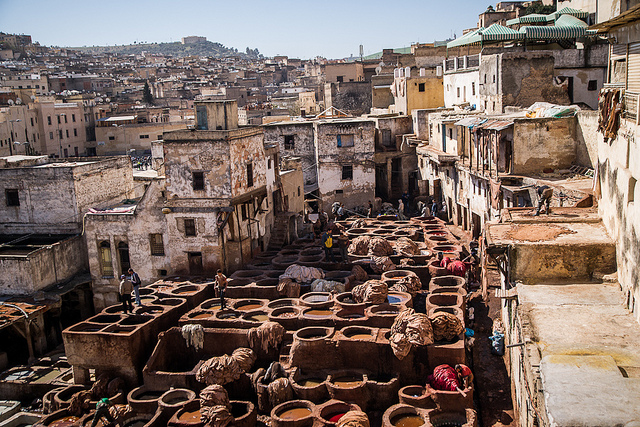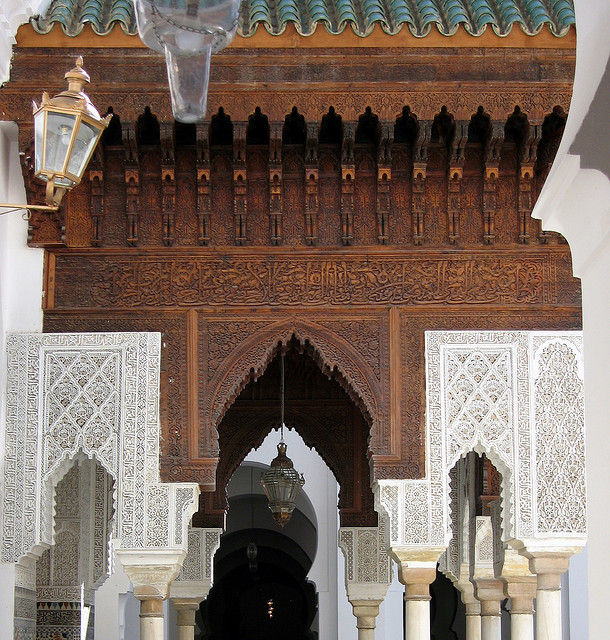When I passed through the Bab Bou Jeloud, better known at The Blue Gate, the awe-inspiring entryway to the medina in Fez, Morocco, I found myself stepping into the ninth century. The onion-shaped arches of the gate made for a dramatic welcome, and its tile-covered facade in bright indigo was hard to miss, adding a splash of color to the earth-toned wall that surrounded “the old city.” I arrived at sunset and unpacked my bags at an inexpensive hotel—only $20 per night—not far from the entrance. To my delight its courtyard was also covered in tile, and I walked to the roof terrace, as suggested by the friendly man at the front desk.

A stretch of the Rue Talaa Kebira in Fez. (Photo: Matt Willis via Flickr)
The view of the ancient city was stunning, overlooking stacks of dwellings in all shades of camel and clay on gently sloping hills, the squarish architecture broken up only by round satellite dishes. Minarets with Moorish detail in aquamarine extended up from the nearby Bou Inania Madrasa and the Abou El Hassan mosque. I looked down into the square below to see a few lights coming on as dusk set in, giving the stalls lining the passageway to the market a warm glow. Peering down at the beginnings of the bustling Talaa Kebira, the longest street in Fez, women in headscarves and colorful kaftans browsed with their daughters, often wearing jeans and t-shirts. Groups of men in hooded robes mingled about, sharing the street with boys on bikes and donkeys pulling carts.
I later learned that with 9,000 streets and a million residents, the medina is the largest and most enduring medieval Islamic settlement in the world. This treasure was named a Unesco World Heritage site in 1981, and is one of the largest car-free urban zones anywhere. Laid out in the ninth century on the Fez River, the 540-acre medina, Fez el-Bali, was a scholarly and commercial center of North Africa and Muslim life, reaching its pinnacle in the 13th and 14th centuries. Once the capital of Morocco, Fez remains the country’s spiritual core.
The following morning, the hotel’s owner arranged a guide for me—a good friend of his—and while at first I was hesitant, wanting to explore on my own, I finally agreed. Winding through the labyrinth of walls, I appreciated Mohammad’s internal GPS; without him I would have spent most of the day walking in circles. He led me down the narrowest “street” in Fez where we had to turn sideways to continue, and into various carpet and ceramics ships along the way.
The highlight was our visit to one of the open air leather tanneries for which Fez is famous. On a warm day you can simply follow your nose, but it takes being with a local to get you inside. If the smell doesn’t knock you out, the vision will take your breath away. While many tourists settle for a view from some nearby terrace, I was accompanied through a maze that opened up into the tannery, and was allowed to take photos and walk through its stone and wooden walkways. I circled the hundred or so round clay vats, built out of varying combinations of bricks, tiles, clay and mud, raw and organic, filled with colorful liquids. I was not three feet from the men toiling in the heat—and even introduced to a few—one waist deep in a vat, smiling wide as he swished and stomped the leather hides.

Leather tannery in Fez. (Photo: Wojtek Ogrodowczyk via Flickr)
Tall stacks of animal hides in various states of decay towered around the parameters of the tannery and fluffy hides were drying on neighboring rooftops. Mohammad explained the process, a craft not much changed since the Middle Ages. First the fresh hides are placed in vats filled with a mixture of limestone, water and pigeon excrement, which contains ammonia that makes the leather soft. Once stripped, the leather is then hand dyed in pots full of pigment: bright reds from poppies and orange from henna, the rich colors popping off the earth-toned surroundings and making for fantastic photos from above.
Afterward, my guide asked me if I’d like to see his home. A little skeptical at first, I knew that Moroccans are known for their hospitality and this wasn’t out of the ordinary. There he introduced me to his wife and two daughters, a giggling child and a teenager, who turned off the TV and made small talk in broken English. His wife served us warm Moroccan-style pita bread topped with melted cheese. We sat around the sofa and sipped strong mint tea in the large traditional two-story building, which was open and airy in the center with a sort of internal courtyard that stretched up to a massive, if a bit ramshackle, sunroof. It was a special treat to be inside his home.
After my initial tour, I felt confident to walk around the markets and streets by myself, venturing further and further each day, occasionally getting lost—which isn’t a bad thing. I passed markets stalls with live animals, dried fruits, heaps and mounds of spices, and a breezy square with a brassy percussion soundtrack, called Place Seffarine, where copper pots were hammered and sculpted. Skilled artisans are everywhere, from women behind open doors at kilns making carpets to young boys and girls in the streets, winding colorful freshly-dyed yarn onto spools. In narrow alleys I stepped aside to allow for passing donkeys delivering goods, and discovered crumbling architectural details everywhere I looked, from elaborate ironwork of dark Spanish doors to intricate Moorish plaster carvings like lace covering the walls.

The University of Al-Karaouine. (Photo: Pierre Metivier via Flickr)
While some entryways I dared not enter, there are many places where Westerners are welcome. Madrassa of Al-Qarawiyyin, a school teaching the Koran as well as all other subjects, located next to the Qarawiyyin mosque in the middle of the medina, is the only madrassa opened to non-Muslims. The University of Al-Qarawiyyin, founded in 859 AD, is considered it to be the oldest university in the world and its libraries have several extremely valuable documents dating from the eighth century, including the Al-Muwatta of Iman Malik written on gazelle parchment. The beautifully-restored Palais M’Hdani is worth a visit. The Batha Museum located in a Moorish palace houses many remarkable artifacts and handicrafts, including sculpted wood, plaster, jewelry, carpets and pottery.
In the evenings, I ate at local restaurants and I fell in love with tagine, the slow-simmered stews served in traditional cone-shaped clay pots. A dramatic presentation, the server lifts the lid to reveal a scrumptious smell. I tried chicken tagine, beef with prunes and almonds, vegetarian tagines with potatoes and carrots, and the more adventurous lamb and mango. At a favorite café near my hotel, where I dined two nights in a row, I was joined by a seventeen-year old boy, “practicing his English” who was sweet and friendly, kept me company during my meals, and said hello when I passed him on the street for the extension of my stay.
I ventured to Fez alone, a woman in my thirties, when my travel companion had to cancel at the last minute. While the friendliness and persistent attention can be a bit overwhelming at times, I never feared for my safety, and in fact, traveling solo enriched my experience. Meeting many locals as well as the other travelers combined with the quiet solitude I felt exploring this archaic city streets made it an adventure like no other.